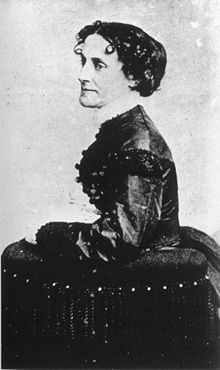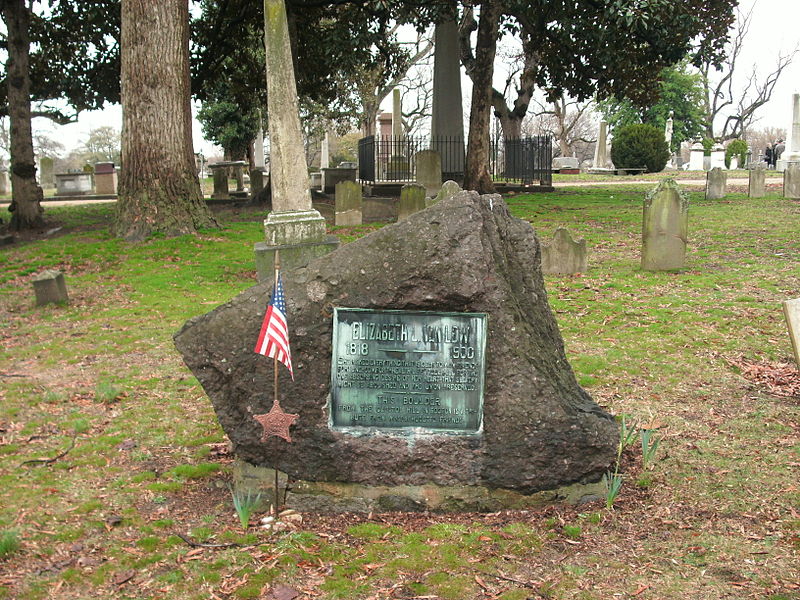Insanely Sane & Steeped in Subterfuge!
In my previous post of Pioneering Women of Civil War America (Eleventh Installment, Part A) about great Union spymaster. . .
Elizabeth “Miss Lizzie” Van Lew (1818-1900)
. . .I left off with a teaser about the most incredulous feat of Miss Lizzie and her spy ring.
It involved locating the grave of Union colonel Ulric Dahlgren (who was killed while trying to take Richmond and free Yankee prisoners) and exhuming and re-burying his body until Miss Lizzie and her cronies re-exhumed and secreted it across Union lines. This they did after it took too long for Confederate president Jefferson Davis to honor the pleas of Colonel Dahlgren’s father, Rear Admiral John A. Dahlgren of the United States Navy, to have his son’s body sent home. Imagine Confederate president Jefferson Davis’ surprise when he found the grave empty. The greater detail of The Colonel Ulric Dahlgren Affair is incredibly interesting—including the desecration of Colonel Dahlgren’s slain body by Rebel troops after they purportedly found papers in his pocket ordering Richmond burned to the ground and Confederate President Jefferson Davis and his cabinet assassinated. However, as it is too lengthy for the remainder of this post, feel free to read more about this story at the link provided within.
Although Miss Lizzie came close a few times, she never got caught spying! What made her so elusive?
First, Victorian women—especially of the elite class—got away with spying because the preponderant societal beliefs were: they would never indulge in such unladylike behavior, and they were mentally and physically incapable of this masculine role.
Second, Miss Lizzie was slier than a fox. She relied heavily upon her instincts, which saved her from revealing her clandestine operation to Rebel undercover agents posing as her allies in spying for the Union and, ultimately, from her execution as a traitor to the Confederacy. And she covered her tracks by using the cipher pictured below for encoding and decoding her missives, which she wrote out in a colorless ink made visible in black by dipping it in milk. Then, she had her coded communications concealed and carried in empty eggshells glued together and placed in baskets amongst whole eggs, shoe heels with secret compartments, or other creative conveyances. According to Miss Lizzie’s niece, Miss Lizzie kept the key to the cipher folded up in her watch case.

So. . .what were Miss Lizzie’s other pioneering deeds?
She was the first person—man or woman—to raise the U.S. flag in Richmond, Virginia, after it fell to the Union in 1865.
She was the first woman to achieve the powerful role as Postmaster of Richmond, Virginia, bestowed upon her by President Ulysses S. Grant in gratitude of her aid. And she was grateful for a paying job; by war’s end, she was impoverished from having donated all of her wealth to the Union.
What in the background of Miss Lizzie—a Southerner—made her a staunch abolitionist, Unionist, and spy against the Confederacy?
You guessed it! Her want of a unified country without slavery! Of the latter, she wrote:
“Slave power crushes freedom of speech and of opinion. Slave power degrades labor. Slave power is arrogant, is jealous and intrusive, is cruel, is despotic, not only over the slave but over the community, the state.”
Although Miss Lizzie’s father was born and raised in Long Island, New York, he employed slaves in his home and successful hardware business. Thus, Miss Lizzie was exposed to Richmond’s slave markets where she witnessed the horrors of black people bound and chained like animals and their families split up and sold separately. But it was the northern roots of her mother, Eliza Baker (whose grandfather was an abolitionist and mayor of Philadelphia from 1796-1798) and schooling by Quaker teachers in Pennsylvania, which influenced Miss Lizzie more.
Upon her father’s death, in 1843, Miss Lizzie and her mother freed their slaves, but not officially on paper to keep them at home under their protection from: some slave catchers who’d rip up manumission papers and sell freedmen back into slavery and a law that decreed freedmen had 1 year to leave the Commonwealth or face re-enslavement. Miss Lizzie and her mother also bought the families of their former slaves and freed them too. These acts. . .
. . .gained the loyalty of their former slaves, who happily volunteered in Miss Lizzie’s underground network!
Sadly, Miss Lizzie died in her home in the company of her forty cats. Friends from Massachusetts, amongst them probably Union prisoners whom she’d helped during the war and/or their families, sent a large crudely cut boulder for her tombstone (pictured below), which sits in Shockoe Hill Cemetery, Richmond, Virginia:
The epitaph reads:
Elizabeth L. Van Lew
1818-1900
She risked everything that is dear to man—friends, fortune, comfort, health, life itself—all for one absorbing desire of her heart—that slavery might be abolished and the union preserved.
Miss Lizzie always wanted the best for the citizens of her beloved Richmond and Virginia. She had hoped they could rise above the North-South schism and lead the United States of America to peace. Once war stated, however, she knew, inevitably, the North would conquer the South and, in the end, there would be great destruction and freedom for the slaves. So, everything she did before and during the Civil War was to help advance the country toward peace and lessen its ruin. Post-war, Miss Lizzie remained loyal to her city and state even when its people shunned her into her eternal life after they discovered the magnitude of her conduct toward the abolition of slavery and the preservation of the Union.
I’ll end here with the hopes that you’ve enjoyed this post and that I’ve whet your appetite to learn more about Elizabeth “Miss Lizzie” Van Lew at the. following places:
Video on My Complimentary Civil War Women Website.
Article at Smithsonian Magazine.com:
“Elizabeth Van Lew, An Unlikely Union Spy”.
Best and Most Scholarly Book (In My Opinion):
Southern Lady, Yankee Spy: The True Story of Elizabeth Van Lew, a Union Spy in the Heart of the Confederacy by Elizabeth R. Varon.
Stay Tuned for the Next Installment of Pioneering Women of Civil War America, Which Promises to Feature. . .
. . .A Southern Lady & Rebel Spy!

Pingback: Pioneering Women of Civil War America (Thirteenth Installment) - Lisa Potocar ~ Author
Pingback: Pioneering Women of Civil War America (Twelfth Installment) - Lisa Potocar ~ Author